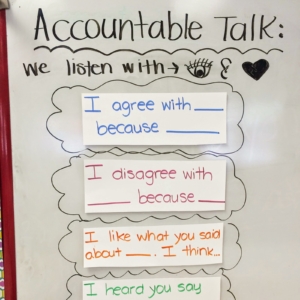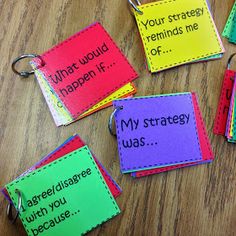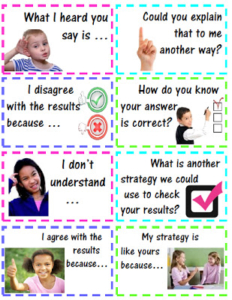Do you find it difficult to get your students to talk about math? Do you feel like the quality of their discussions could improve? Here are four steps that will increase the success of accountable talk in your class!
Step 1: Introduce accountable talk stems
Accountable talk stems are a guide for students to use as they discuss and respond to each other about their thinking, so meaningful conversation and learning can occur. Starting with a few at the beginning of the year, and adding more later on is a great way to get students to use them, without feeling overwhelmed. Make these stems visible and accessible to your students. The stems could be on cards, laminated and put on rings for students to use when having a discussion. Another idea is to have an anchor chart where they are displayed.
Step 2: Model using the accountable talk stems
Using another adult or a student as a discussion partner, model having a discussion using the accountable talk stems. We don’t often model in math, but modeling how to have a discussion is key to your students having success with this practice throughout the year. Modeling how to act while discussing is important as well. Looking your partner in the eye, listening, and responding with quality feedback are essential. Setting these expectations and procedures at the start of the year will lead to high level thinking and discussions taking place in your class every day.
Step 3: Practice accountable talk with non-content related and prior grade level content questions
If you could bring one item to a deserted island you were stuck on, what would it be and why? The beginning of the school year is a PERFECT time to practice having discussions using stems with silly questions. Not only are the students getting to practice what you have modeled with low stress questions, they are getting to know each other as fellow classmates. The first 9 days of the school year are also a great time to practice accountable talk with content from the previous grade level, as the Building Math Community resource suggests. During this practice with accountable talk, teachers can observe the discussions that are taking place and continue modeling based on what students need to improve on.
Step 4: It’s time to start talking about math, but remember these important strategies
• Not all questions will lend themselves well to students having a discussion with a partner(s). Having students discuss high level questions will lead to quality thinking and learning.
o Example: The product is 42, what are possible factors? Justify your thinking in pictures or words
o Non-Example: What is the product of 7 and 6?
• Allow students to have wait time before they discuss. This will give students a chance to process the question and will give them more confidence in communicating their thinking and responding to their partner. Wait time can include thinking and/or jotting key points about what they want to discuss in their journals.
• Hold students accountable during their discussion by walking around and listening. After the discussion, students can be held accountable by explaining what their partner said to the class and reflecting on what they learned during the discussion.
• While students are discussing and you are walking around, listen for thinking that all students in the class need to hear to help the class reach the learning goal of the lesson. Highlight excellent thinking by calling on those students to share with the class.
• Use talk moves during whole class discussions that will continue to hold students accountable. For example, after a student shares an important thought that you want to be sure the whole class hears, have another students repeat what they said. Watch this video for more information about talk moves.
For more information about accountable talk in the math class, read this article from Math Solutions. Also, don’t forget to visit your Building Math Community resource located on your Year at a Glance for each grade to get more ideas on Accountable Talk and how to get it started in your math classroom.





Pingback: 4 Strategies to Engage ALL Learners in Mathematical Discourse | SMathSmarts